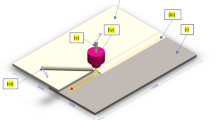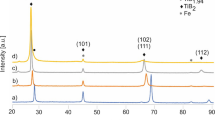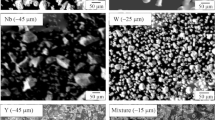Abstract
SPS-processed alumina and reaction-bonded boron carbide ceramic composite (RBBC) were joined with Al10SiMg alloy by spark plasma sintering and tested in a series of planar impact experiments designed to measure dynamic tensile (spall) strength of the joints. The results of the impact testing, together with postmortem inspection of the fractured samples, confirmed the applicability of this approach for testing joint strength. The measurements show that in the case of an RBBC/metal joint, the dynamic tensile strength of the joint exceeds that of the ceramic part, and that fracture of the shock-loaded ceramic–metal pair occurred in the ceramic portion. The dynamic tensile strength of the interface between alumina and Al10SiMg alloy virtually coincides with that of the metal part, with the fracture occurring exactly at the interface. The coincidence may be explained based on the recently published results of atomistic calculations of the structure of an alumina–aluminum interface.








Similar content being viewed by others
References
Howe JM (1993) Bonding, structure and properties of metal/ceramic interfaces. Mater Res Symp Proc 314:27–37
Lemus-Ruiz J, Aguilar-Reyes EA (2004) Mechanical properties of silicon nitride joints using a Ti-foil interlayer. Mater Lett 58(19):2340–2344
Centeno A, Rocha VG, Borrell A, Blanco C, Fernandez A (2012) Fabrication of C/SiC composites by combining liquid infiltration process and spark plasma sintering technique. Ceram Int 38:2171–2175
Guillard F, Allemand A, Lulewicz J-D, Galy J (2007) Densification of SiC by SPS—effects of time, temperature and pressure. J Eur Ceram Soc 27:2725–2728
Luo Y, Li S, Pan W, Li L (2004) Fabrication and mechanical evaluation of SiC–TiC nanocomposites by SPS. Mater Lett 58:150–153
Liu W, Naka M (2003) In situ joining of dissimilar nanocrystalline materials by spark plasma sintering. Scripta Mater 48:1225–1230
Rizzo S, Grasso S, Salvo M, Casalegno V, Reece MJ, Ferraris M (2014) Joining of C/SiC composites by spark plasma sintering technique. J Eur Ceram Soc 34:903–913
Miriyev A, Barlam D, Shneck R, Stern A, Frage N (2014) Steel to titanium solid state joining displaying superior mechanical properties. J Mater Process Technol 214:2884–2890
Miriyev A, Stern A, Tuval E, Kalabukhov S, Hooper Z, Frage N (2013) Titanium to steel joining by spark plasma sintering (SPS) technology. J Mater Process Technol 213:161–166
Baumung K, Kanel GI, Müller G, Singer J (2000) Measurement of the adhesive strength of 200 µm thick turbine blade coatings by a dynamic method, shock compression of condensed matter—I999. AIP 505:1207–1210. https://doi.org/10.1063/1.1303678
Girlitsky I, Zaretsky E, Kalabukhov S, Dariel MP, Frage N (2014) Dynamic compressive and tensile strengths of spark plasma sintered alumina. J Appl Phys 115:243505. https://doi.org/10.1063/1.4885436
Hayun S, Weizmann A, Dariel MP, Frage N (2009) The effect of particle size distribution on the microstructure and the mechanical properties of boron carbide-based reaction-bonded composites. Int J Appl Ceram Technol 6(4):492–500
Barker LM, Hollenbach RE (1972) Laser interferometer for measuring high velocities of any reflecting surface. J Appl Phys 43:4669–4775
Kanel GI (2010) Spall fracture: methodological aspects, mechanisms and governing factors. Int J Fract 163:173–191. https://doi.org/10.1007/s10704-009-9438-0
Chen X, Asay JR, Dwivedi SK, Field DP (2006) Spall behavior of aluminum with varying microstructures. J Appl Phys 99:023528
Barker LM, Hollenbach RE (1970) Shock-wave studies of PMMA, fused silica, and sapphire. J Appl Phys 41:4208–4226. https://doi.org/10.1063/1.1658439
Kanel GI, Razorenov SV, Fortov VE (2004) Shock-wave phenomena and the properties of condensed matter. Springer, New York, p 33
Antoun T, Seaman L, Curran D, Kanel GI, Razorenov SV, Utkin AV (2002) Spall fracture. Springer, New-York, Berlin, Heidelberg, p 90, 99
Duvall GE, Graham RA (1977) Phase transitions under shock-wave loading. Rev Mod Phys 49(3):523–577
Pilania G, Thijsse BJ, Hoagland RG, Lazić I, Valone SM, Liu X-Y (2014) Revisiting the Al/Al2O3 interface: coherent interfaces and misfit accommodation. Sci Rep 4:4485. https://doi.org/10.1038/srep04485
Zaretsky E (1995) Dislocation multiplication behind the shock front. J Appl Phys 78:3740. https://doi.org/10.1063/1.359954
Gallagher PCJ (1970) The influence of alloying, temperature, and related effects on the stacking fault energy. Metall Trans 1(9):2429–2461
Acknowledgements
Financial support by the Israeli Ministry of Defense to Prof. E. Zaretsky (Grant 87576411) and to Prof. N. Frage (Grant 87541011) is gratefully acknowledged.
Author information
Authors and Affiliations
Corresponding author
Rights and permissions
About this article
Cite this article
Hayun, S., Ionash, E., Kalabukhov, S. et al. Strength of ceramic–metal joints measured in planar impact experiments. J Mater Sci 53, 8211–8220 (2018). https://doi.org/10.1007/s10853-018-2151-5
Received:
Accepted:
Published:
Issue Date:
DOI: https://doi.org/10.1007/s10853-018-2151-5




